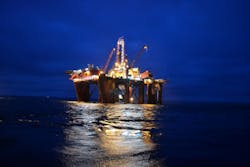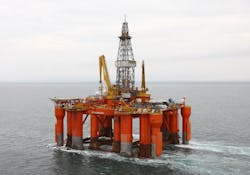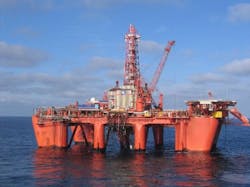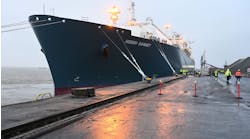One of Europe’s oldest drilling contractors is back from the brink, having been saved from financial collapse last summer by its creditors and a US-based investor. Dolphin Drilling now has new management, led by former Songa Offshore CEO Bjørnar Iversen, with operations bases in Aberdeen and Stavanger.
The company, formed in 1965, was previously based in Oslo as part of the family-owned Fred Olsen Group of shipping companies. At its peak in 2013 Dolphin had a fleet of 11 offshore rigs in operation and two newbuilds under construction, a semisubmersible and a deepwater drillship, both booked for big contracts. Then the downturn hit, the contracts were cancelled, and with the rest of the fleet also coming off contracts, the debt burden eventually became too large to manage.
During the same period, Norwegian rival Songa Offshore also had multiple newbuilds coming off the production lines in South Korea, but these were locked in on long-term contracts with Equinor offshore Norway. So while other drillers were starting to suffer, Songa Offshore was able to increase its work volumes, and that paved the way for the sale of the company, led by Iversen, to Transocean.
The opportunity to acquire Dolphin started in July, August 2018, when the company first received an approach from its current majority owner, Strategic Value Partners (SVP). “SVP is an American private equity group,” Iversen said, “that typically invests in debt and restructuring. It then builds up the balance sheet and pulls out after a period of time. SVP has invested in debt held by Seadrill and is also the largest shareholder in Pacific Drilling.
“Dolphin had a great history, and we foresaw a great future for the company. Despite its problems, it had a robust organization and good rigs, which we thought would be a decent starting point after clearing up the mess of its balance sheet. We felt it had a lot to contribute to operations on the UK and Norwegian continental shelves and other geographical areas.”
Last April, however, the company was in an impossible situation, with debts totalling over $1 billion and zero cashflow. At that point the majority lenders party to the company’s secured $2-billion credit facility provisionally agreed to a reorganization and recapitalization of the drilling business. The terms included the sale of the deepwater drillship Bolette Dolphin with a re-focus on harsh environment North Sea and mid-water drilling, this business to be transferred to a new holding company controlled by the secured lenders; and the dismissal of Dolphin’s entire drilling management. All the proposals were approved in late June, with investment funds advised by SVP serving as main shareholders of the reconstructed company.
The rig fleet now comprises the semisubmersibles Bideford Dolphin, Blackford Dolphin and Borgland Dolphin. “We lost Bolette Dolphin, which was probably one of the world’s best drilling vessels, but a big part of the debt was linked to it, and that had to be cleared. So, the company came out of its crisis debt-free, with good liquidity. The drillship is still held for sale, the debt holder is still the owner, and in the meantime we continue to manage the vessel.”
Iversen has since brought in a new team that includes CFO Steven Cox, formerly with Transocean Sedco Forex, and Chief Commercial Officer Steen Damgaard, previously with Maersk Drilling. “The company had its legacy and culture, and we are changing that. One of the main changes is that the culture of our top management is now much closer to the businesses with headquarters split between Aberdeen and Stavanger. But it’s also about implementing a compact organization involving new working practices and smart use of new technologies.
“A lot of people in this industry talk about ‘rigs for the future’, but we and others are more focused on becoming the ‘driver of the future’. That means, a driller very well integrated with the customers’ needs and prepared to ally with suppliers to provide solutions as part of a cost-effective organization. Drilling in future will have to be more competitive, with integrated operations, more asset-light, while at the same time, technology-driven. We are seeing these trends in the UK, Norway, and many other offshore areas.”
All three of the company’s current fleet are Aker H3 4th generation semis built in the mid-1970s. The Bideford Dolphin and Borgland Dolphin, currently targeted at UK/Norwegian North Sea operations, both underwent major upgrades in the late 1990s. The Blackford Dolphin, the oldest of the trio, was converted in 2006 for deepwater operations at the Keppel Verolme shipyard in Rotterdam, and is being marketed for UK and international projects (it is not certified to work offshore Norway). “Around $1.3 billion has been invested in that rig since 2004,” Iversen said, “so it may be the most expensive of its type in the world. Its drilling package, which includes Auto-Driller, is technically on a par with relatively new (6th generation) semis such as Deepsea Stavanger. Dolphin has retained a small team and offices in Singapore and Brazil. “If we get work in those regions for the Blackford Dolphin we will use that structure as a springboard for growth,” Iversen said. “The Blackford can operate in water depths down to 1,800 m [5,905 ft] and there is a lot going on in Brazil, the market for drilling there seems to be really picking up.
“The Bideford and the Borgland are suitable for exploration campaigns, subsea developments, workovers and P&A. Both featured strongly for three years in a row in a recent ranking system, with the Bideford receiving an award as most efficient rig of the year, in competition with newer, purpose-built harsh environment semis such as Deepsea Atlantic and Transocean Spitsbergen. So newer rigs are not necessarily better, but they do come with a lot of debt and are therefore expensive to operate. And a lot of them also use a lot of fuel: some of the newer semis operating in the North Sea area typically burn up 100-150 b/d or more, so their fuel costs and CO2 [carbon-dioxide] emissions are higher than our older, but ‘greener’ rigs which are chained to the seabed.
“Our rigs have each undergone recent Special Periodic Surveys. They don’t require any further structural upgrades although we are looking at equipping them with hybrid power packages in order to bring their fuel costs down. And we are prioritizing investments that would give customers the real data that they need, also adding new technologies via partnerships with our suppliers that are more compact and which facilitate more integrated operations.”
Last month the Borgland Dolphin was due to start a potential four-month campaign for Norske Shell drilling and completing a new gas production well on the Knarr field in the North Sea, with options for up to two more wells. Previously the rig was contracted for almost nine months to London-based independent i3 Energy, performing exploration, appraisal and testing on the Liberator and Serenity oil accumulations in the UK central North Sea, after having switched from standby to operational mode in 70 days, thought to be a record for a fast offshore rig turnaround.
Dolphin has since entered a four-year frame agreement with i3 Energy that would encompass development drilling, assuming i3 Energy secures project sanctions for the two fields. The arrangement could involve Dolphin itself providing financial assistance to ensure the program goes forward. “We aim to find win-win situations with our customers,” Iversen said. “We are prepared to enter contractual and service arrangements that are performance-driven: customers appreciate that, and we expect a high degree of interest in this type of service under which the driller shares more of the responsibility with the client for the success of the program.”
Dolphin can contemplate a higher-risk model, Iversen explained, because the company is debt-free “with a solid backer and liquidity that gives it the capability to grow, unlike most other drillers which are loaded with debt that they are forced to service - rather than their customers - without much room to operate in. Over the past couple of years this situation has led to Transocean acquiring Songa Offshore and Ocean Rig, and Ensco/Rowan joining forces to form Valaris – and I think other mergers could well follow. A lot of it is due to drillers’ heavy financial difficulties and the need for restructuring, as happened with Seadrill and Noble.
“There is still room for scrapping in this sector. We ourselves have gone from 11 to three rigs; others would also like to cut the size of their fleets, but due to their debt situations and covenants, it’s hard for them to do so. Nevertheless, a significant number of rigs will be scrapped and this will help to balance the market, because day rates have to come up for the market to be sustainable.” •






